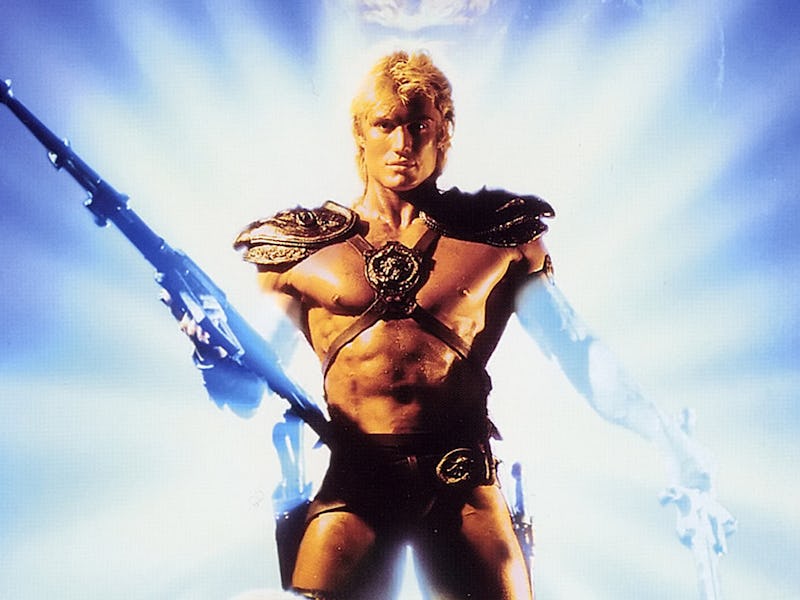35 years ago, an ’80s box office bomb gave us the best sci-fi villain ever
The Masters of the Universe movie could have had it all. Instead, it made one of the most nonsensical choices in genre movie history.

Skeletor crashes the prom is a weird pitch for a sci-fi/fantasy action movie. And yet, it perfectly describes the plot of Masters of the Universe. On Aug. 7, 1987, He-Man battled Skeletor not just on Eternia but also on planet Earth. And that single narrative decision — to cross worlds and essentially change a fundamental aspect of the He-Man concept — remains one of the strangest choices in all of movie history.
Like Star Wars, the vast majority of the regular He-Man and the Masters of the Universe animated television series, which ran for two seasons of 65 episodes each from 1983 to 1985, doesn’t take place on Earth but rather in a corner of the universe containing the planet Eternia. (And later, when She-Ra is introduced, the planet Etheria, which exists in a different dimension altogether.) Like Game of Thrones, part of what made the setting of He-Man click was that it didn’t happen on Earth, and references and connections to Earth were rare. (Though they did happen!) From a genre perspective, this let He-Man, like Battlestar Galactica, exist in a funky liminal space between fantasy and science fiction. Relative to Earth, most kids just didn’t think about it too hard.
Again, a Star Wars comparison is tempting here because, after 1977, a ton of high-concept movies and TV shows wanted to get that same cocktail of “vague sci-fi world-building but can we have some magic and swords, too?” In the cartoon version of He-Man, these anachronisms tended to make sense. But once the film version crossed over to Earth, whatever corny magic the franchise had previously was diminished.
Frank Langella as Skeletor.
For kids of the ’80s who grew up with He-Man, it wasn’t that the live-action Masters of the Universe was a betrayal so much as it felt oddly more fake than the cartoon. Because the movie knew it couldn’t capture the fantasy kingdom vibe of the show, it didn’t even try. As an adaptation of a very popular kids’ brand, Masters of the Universe is bizarre because its unfaithfulness actually forgets what kids liked about it: It was pure escapism.
Unlike the Transformers, the titular masters of the universe of the series rarely interacted with the children of the Earth. (Though a funky 1985 Christmas special is a notable exception.) Other than He-Man breaking the fourth wall to teach us various civic lessons at the end of every episode (a studio-mandated narrative device), this universe remained relatively self-contained. No one would ever dream of doing a Hobbit movie in which Bilbo Baggins comes to Earth in search of the Ring, but that’s basically what Masters of the Universe is.
If you are somehow able to set aside the fact that Masters of the Universe shouldn’t have gone to Earth but merely had to for budget reasons, then it becomes a slightly more interesting film. Because the movie is essentially a compromise between high fantasy and a quirky fish-out-of-water sci-fi story in the vein of E.T. the Extra-Terrestrial, it’s hard to find any other movie quite like it. Masters of the Universe is like if the 1986 Highlander had been made for children, but that analogy also requires you to imagine Highlander was somehow based on the Smurfs.
Masters of the Universe is an amazing chimera of styles. At one point in the film, Skeletor (Frank Langella) easily tops any great Palpatine speech, delivering the following line: “Tell me about the loneliness of good, He-Man. Is it equal to the loneliness of evil?” At the same time, it’s also a movie that features a silly, sunglass-wearing elf-creature named Gwildor who gets into all sorts of hijinks on Earth, circa 1987.
Toward the climax of the movie, half of a car and some of a brick wall are transported to Eternia, making it seem like both settings were unfinished. If you squint, this gives the movie a kind of minimalist, avant-garde aesthetic. Tonally, it’s not hammy or intentionally kitsch like the 1980 Flash Gordon adaptation. Instead, it’s honest and forthright, which makes the basic incongruity of the movie a little more fun to watch.
Half a car and a brick wall is teleported to Eternia in the climax of Masters of the Universe.
The legacy of the Masters of the Universe will always be mixed, but the on-screen talent involved in the film is especially staggering in retrospect. Although Dolph Lundgren has been widely quoted saying he disliked the role of He-Man (it’s even on the Wikipedia page for the movie!), in the 2019 documentary The Power of Grayskull, he very clearly mentions that he was proud to make the movie. Ditto Frank Langella who, again, gives the performance of his life as Skeletor and, in doing so, created the most underrated cinematic sci-fi/fantasy villain of all time. If you watch (or rewatch) the movie for only one reason, that reason is Langella.
Masters of the Universe even has its own version of “May the Force Be With You” — the far more generic, yet somewhat touching “Good journey.” He-Man and the gang explain to Julie (Courteney Cox) that they don’t say goodbye on Eternia, they say, “Good journey.” And if there’s one retcon from the animated show that made sense for the movie, it’s that one. Because, for all of its flaws, the journey of Masters of the Universe feels good even when parts of it are really bad. And that’s probably why, on some level, we can never say goodbye.
Correction: A previous version of this piece claimed the animated He-Man never made a connection to Earth. This is false. References were, however, rare.
Masters of the Universe is streaming now on HBO Max.